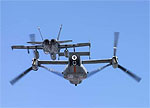Bell-Boeing team tests Osprey's ability to refuel other aircraft
 The medium-lift Osprey, proven in combat as a troop and equipment transport, could soon get a new mission: refueling other aircraft.
The medium-lift Osprey, proven in combat as a troop and equipment transport, could soon get a new mission: refueling other aircraft.
A series of tests in August and September has given aviation officials hope that the Osprey could be used to extend the range of other platforms, including helicopters and the F-35 Joint Strike Fighter.
The tests were conducted on the Marine Corps’ MV-22, but also served as a “proof of concept” for the V-22 program as a whole, and would work with the Air Force’s CV-22 variant, said Ken Karika, business development manager for the Bell Helicopter Textron and Boeing CV-22 team.
The Marine Corps and Navy requested the test, and it was performed on a leased MV-22, but the system is identical to what would be used on an Air Force Osprey, Karika said.
The first tests of the aerial refueling system under development by Bell and Boeing determined how turbulence from the Osprey’s rotors affect the hose and drogue that deliver fuel to other aircraft, as well as how rotary-wing and jet aircraft react in the Osprey’s rotor wash. A high-speed test for jet aircraft was conducted on Aug. 29 and a second, low-speed rotary-wing test on Sept. 23. Each type of aircraft requires a slightly different drogue, although it can be changed on the ground to meet the mission.
“The indications are that it’s really a steady drogue back there,” said Marine Brig. Gen. Matthew Glavy, assistant deputy commandant for Marine Corps aviation. “The Hornet pilots were really impressed with what they saw.”
During the Aug. 29 test, two F-18 Hornets from III Marine Aircraft Wing out of Marine Corps Air Station Miramar, Calif., flew to Fort Worth, Texas, where the Bell Boeing team conducted proof of concept testing. No refueling occurred, but a water-filled hose was used to determine if a hose could be extended and retracted safely from an Osprey.
“If this thing is bouncing around, there is really no reason to go further,” Glavy said. “But what we saw in this demonstration is it doesn’t. It’s a steady target.”
The second test, with rotary-wing aircraft, also didn’t involve a fuel exchange. But it proved that the drogue is steady when the Osprey has its nacelles — the engine enclosures — at 60-degree angles, rather than in the horizontal airplane mode, said Chad Sparks, the V-22 advanced derivatives manager at Bell Boeing.
The development is important, Glavy said, because it will enhance the capability of other aircraft.
“So we have a 450-nautical-miles F-35, and if I have a capability to do tanking both en route to the objective and for recovery, I have just taken that distance and increased it significantly,” Glavy said.
The Osprey could carry as much as 12,000 extra pounds of fuel in up to three auxiliary fuel tanks that are already in use and standard for the Osprey, Sparks said.
Because most of the refueling technology already exists or is native to the Osprey platform, the V-22 could be outfitted on short notice for any number of missions.
“One day it could just carry troops or cargo. The next day it may be needed to operate as a tanker,” Sparks said.
Ground crews would simply roll auxiliary fuel tanks into the cabin, bolt them down and the Osprey would be ready to go.
The next step is to discuss the fuel capacities, fueling rates, and level of integration with other aircraft that military officials want, Sparks said.